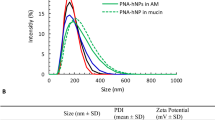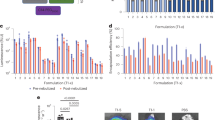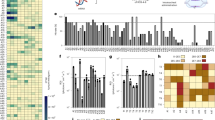Abstract
Polyethylenimine (PEI), a polycation with high ionic charge density, has recently been used as a gene therapy delivery agent. We have defined the optimal conditions for PEI-based transfection of airway epithelial cells in vitro and in vivo and used these conditions to restore Cl− channel activity in a CF mouse model. Three forms of PEI, a linear 22 kDa (ExGen 500) form and branched 25 or 50 kDa forms were evaluated. All forms of PEI significantly increased luciferase reporter gene expression compared to the liposome DCChol/DOPE in a human bronchial epithelial cell line (16HBE) irrespective of the extent of cell confluency. With subconfluent cells, gene expression was around 1000-, 200- and 25-fold higher than liposomes using linear 22, 25 and 50 kDa PEI, respectively. The transfection efficiency was reduced in confluent and polarized epithelial cells but linear 22 kDa PEI showed the smallest decrease and gave 8000-fold better transfection in polarized cells compared to liposomes. A comparison of linear 22 or 25 kDa PEI with DCChol/DOPE for airway delivery in vivo via intranasal instillation was also performed. Linear 22 kDa PEI gave significantly better luciferase reporter gene expression of 350-fold in the lung, 180-fold in the nose and 85-fold in the trachea compared to liposome. In contrast, the 25 kDa form of PEI was no better than DCChol/DOPE. Repeat dosing with linear 22 kDa PEI failed to give reporter gene delivery comparable to the initial dose. To establish that PEI can be used to deliver a physiologically relevent gene in vivo, we used it to restore Cl− secretion by CFTR gene delivery in the airways of a CF mouse model.
This is a preview of subscription content, access via your institution
Access options
Subscribe to this journal
Receive 12 print issues and online access
$259.00 per year
only $21.58 per issue
Buy this article
- Purchase on Springer Link
- Instant access to full article PDF
Prices may be subject to local taxes which are calculated during checkout





Similar content being viewed by others
References
Riordan JR et al. Identification of the cystic fibrosis gene: cloning and characterization of complementary DNA. Science 1989; 245: 1066–1073.
Gill DR et al. A placebo-controlled study of liposome-mediated gene transfer to the nasal epithelium of patients with cystic fibrosis. Gene Therapy 1997; 4: 199–209.
Hyde SC et al. Repeat administration of DNA/liposomes to the nasal epithelium of patients with cystic fibrosis. Gene Therapy 2000; 7: 1156–1165.
Alton EW et al. Cationic lipid-mediated CFTR gene transfer to the lungs and nose of patients with cystic fibrosis: a double-blind placebo-controlled trial. Lancet 1999; 353: 947–954.
Knowles MR et al. A double-blind, placebo controlled, dose ranging study to evaluate the safety and biological efficacy of the lipid–DNA complex GR213487B in the nasal epithelium of adult patients with cystic fibrosis. Hum Gene Ther 1998; 9: 249–269.
Zabner J et al. Comparison of DNA–lipid complexes and DNA alone for gene transfer to cystic fibrosis airway epithelia in vivo. J Clin Invest 1997; 100: 1529–1537.
Porteus DJ et al. Evidence for safety and efficacy of DOTAP cationic liposome mediated CFTR gene transfer to the nasal epithelium of patients with cystic fibrosis. Gene Therapy 1997; 4: 210–218.
Boussif O et al. A versatile vector for gene and oligonucleotide transfer into cells in culture and in vivo: polyethyleneimine. Proc Natl Acad Sci USA 1995; 92: 7297–7301.
Goula D et al. Polyethylenimine-based intravenous delivery of transgenes to mouse lung. Gene Therapy 1998; 5: 1291–1295.
Godbey WT, Wu KK, Mikos AG . Tracking the intracellular path of poly(ethylenimine)/DNA complexes for gene delivery. Proc Natl Acad Sci USA 1999; 96: 5177–5181.
Remy JS et al. Taking lipospermines and polyethylenimine from in vitro to in vivo. In: Kabanov AV, Felgner PL, Seymour LW (eds). Self-assembling Complexes for Gene Delivery: From Laboratory to Clinical trial. John Wiley and Sons Ltd.: New York.
Ferrari S et al. ExGen 500 is an efficient vector for gene delivery to lung epithelial cells in vitro and in vivo. Gene Therapy 1997; 4: 1100–1106.
Ferrari S et al. Polyethylenimine shows properties of interest for cystic fibrosis gene therapy. Biochim Biophys Acta 1999; 1447: 219–225.
Bragonzi A et al. Comparison between cationic polymers and lipids in mediating systemic gene delivery to the lungs. Gene Therapy 1999; 6: 1995–2004.
Goula D et al. Rapid crossing of the pulmonary endothelial barrier by polyethlenimine/DNA complexes. Gene Therapy 2000; 7: 499–504.
Bragonzi A et al. Biodistribution and transgene expression with nonviral cationic vector/DNA complexes in the lungs. Gene Therapy 2000; 7: 1753–1760.
Zou SM, Erbacher P, Remy JS, Behr JP . Systemic linear polyethylenimine (L-PEI)-mediated gene delivery in the mouse. J Gene Med 2000; 2: 128–134.
Chollet P, Favrot MC, Hurbin A, Coll JL . Side effects of a systemic injection of linear polyethylenimine–DNA complexes. J Gene Med 2002; 4: 84–91.
Densmore CL et al. Aerosol delivery of robust polyethyleneimine–DNA complexes for gene therapy and genetic immunization. Mol Ther 2000; 1: 180–188.
Gautam A, Densmore CL, Xu B, Waldrep JC . Enhanced gene expression in mouse lung after PEI–DNA aerosol delivery. Mol Ther 2000; 2: 63–70.
Cozens AL et al. CFTR expression and chloride secretion in polarized immortal human bronchial epithelial cells. Am J Respir Cell Mol Biol 1994; 10: 38–47.
Cozens AL et al. A transformed human epithelial cell line that retains tight junctions post crisis. In Vitro Cell Dev Biol 1992; 28A: 735–744.
Krieg AM et al. CpG motifs in bacterial DNA trigger direct B-cell activation. Nature 1995; 374: 546–549.
Ratcliff R et al. Production of a severe cystic fibrosis mutation in mice by gene targeting. Nat Genet 1993; 4: 35–41.
Goddard CA, Evans MJ, Colledge WH . Genistein activates CFTR-mediated Cl− secretion in the murine trachea and colon. Am J Physiol 2000; 279C: 383-C392.
Brunner S et al. Overcoming the nuclear barrier: cell cycle independent nonviral gene transfer with linear polyethylenimine or electroporation. Mol Ther 2002; 5: 80–86.
Mortimer I et al. Cationic lipid-mediated transfection of cells in culture requires mitotic activity. Gene Therapy 1999; 6: 403–411.
Li S et al. Effect of immune response on gene transfer to the lung via systemic administration of cationic lipidic vectors. Am J Physiol 1999; 276L: 796-804.
Uduehi AN et al. Effects of linear polyethylenimine and polyethylenimine/DNA on lung function after airway instillation to rat lungs. Mol Therapy 2001; 4: 52–57.
Hartikka J et al. An improved plasmid DNA expression vector for direct injection into skeletal muscle. Hum Gene Therapy 1996; 7: 1205–1217.
MacVinish LJ et al. Chloride secretion in the trachea of null cystic fibrosis mice: the effects of transfection with pTrial10-CFTR2. J Phys 1997; 499: 677–687.
Gautam A et al. Transgene expression in mouse airway epithelium by aerosol gene therapy with PEI–DNA complexes. Mol Ther 2001; 3: 551–556.
Acknowledgements
This work was supported by the CF Trust (UK). WHC is supported by the Ford Physiology Fund.
Author information
Authors and Affiliations
Rights and permissions
About this article
Cite this article
Wiseman, J., Goddard, C., McLelland, D. et al. A comparison of linear and branched polyethylenimine (PEI) with DCChol/DOPE liposomes for gene delivery to epithelial cells in vitro and in vivo. Gene Ther 10, 1654–1662 (2003). https://doi.org/10.1038/sj.gt.3302050
Received:
Accepted:
Published:
Issue Date:
DOI: https://doi.org/10.1038/sj.gt.3302050
Keywords
This article is cited by
-
Intranasal delivery of plasmids expressing bovine herpesvirus 1 gB/gC/gD proteins by polyethyleneimine magnetic beads activates long-term immune responses in mice
Virology Journal (2021)
-
Pigment Epithelium-Derived Factor Promotes Axon Regeneration and Functional Recovery After Spinal Cord Injury
Molecular Neurobiology (2019)
-
Non-viral-mediated suppression of AMIGO3 promotes disinhibited NT3-mediated regeneration of spinal cord dorsal column axons
Scientific Reports (2018)
-
Molecular Architecture Governs Cytotoxicity and Gene Transfection Efficacy of Polyethylenimine Based Nanoplexes in Mammalian Cell Lines
Journal of Inorganic and Organometallic Polymers and Materials (2015)
-
Intratracheal Gene Transfer of Adrenomedullin Using Polyplex Nanomicelles Attenuates Monocrotaline-induced Pulmonary Hypertension in Rats
Molecular Therapy (2009)



